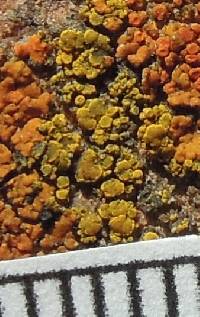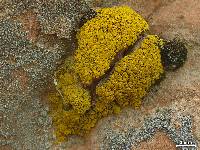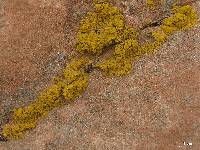
Consortium of Lichen Herbaria
- building a Global Consortium of Bryophytes and Lichens as keystones of cryptobiotic communities -
- Home
- Search
- Images
- Species Checklists
- US States: O-Z >
- US National Parks
- Central America
- South America
- US National Parks
- Southern Subpolar Region
|
|
|
|
Family: Candelariaceae
|
Nash, T.H., Ryan, B.D., Gries, C., Bungartz, F., (eds.) 2004. Lichen Flora of the Greater Sonoran Desert Region. Vol 2. Thallus: bullate to lobate to rosulate to squamulose, sometimes forming rosettes squamules: rounded to lobate, sometimes raised from the substrate; lobes: crenate to incised, up to c. 1 mm long surface: yellow to orange yellow, smooth to coarse cortex: pseudoparenchymatous, 5-15 µm thick Apothecia: common, lecanorine, 0.4-1.2(2.2) mm wide disc: darker yellow than the thallus, flat to somewhat convex margin: thick, entire to crenulate, persistent exciple: thin, not visible from the outside epihymenium: yellow-brown hymenium: hyaline below, 60-70 µm tall; paraphyses: simple or sometimes branched above, cylindrical or swollen apically with up to 5 µm wide tips; hypothecium: hyaline asci: clavate, 8-spored ascospores: hyaline, simple to 1-septate, oblong to narrowly ellipsoid, 11-21 x 5-6.5 µm Pycnidia: common, appear as darker yellow warts on the thallus conidia: hyaline, oblong to ellipsoid, 2.5-3.5 x 1.5 µm Spot tests: K+ reddish, KC-, C- Secondary metabolites: calycin, pulvinic acid, pulvinic dilactone and vulpinic acid. Substrate and ecology: mostly on calcium-free rocks, but sometimes also on more calcium-rich rocks, rarely on wood and tree bases World distribution: western North America Sonoran distribution: on rocks in Arizona, southern California, Baja California, Sonora, and Chihuahua. Notes: Candelariella rosulans is a common species north of the Mexican border. Although variable in appearance, it is normally lobate and sometimes forms rosulate thalli. The spores are usually ±oblong and never have pointed ends. Compared to C. "complanata", it has a thicker, more convex thallus and broader spores. Often it grows together with C. citrina and the color difference between the two species is usually significant. |
|
|
|
Powered by Symbiota








































































































